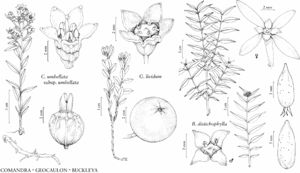Comandra umbellata subsp. umbellata
Herbs or subshrubs, 7–40 cm. Rhizomes: cortex white to beige. Aerial stems usually branched, sometimes much-branched at base; proximal portions overwintering or not. Leaves: blade green, paler abaxially, not glaucous, lanceolate, oblanceolate, elliptic, or ovate, 0.7–5 (–7.6) cm, thin, soft, base attenuate to acute, margins often slightly revolute, apex obtuse, sometimes apiculate; midrib and lateral-veins conspicuous, protruding on abaxial surface. Pedicels 0–1.4 mm. Flowers funnel-shaped to almost rotate; petals lanceolate, lanceolate-oblong, or ovate, 2–3 mm; anthers 0.5 mm. Pseudodrupes dark to light-brown, sometimes red-tinged, not glaucous, subglobose to globose, 4–6 mm, smooth. 2n = 28.
Phenology: Flowering Mar–Aug.
Habitat: Swamps and bogs, rich mesic sites, dry, sandy or rocky soils, savannas, early successional forests.
Elevation: 0–700 m.
Distribution

Alta., B.C., Man., N.B., Nfld. and Labr., N.S., Ont., P.E.I., Que., Sask., Ala., Ark., Conn., Del., D.C., Ga., Ill., Ind., Iowa, Kans., Ky., Maine, Md., Mass., Mich., Minn., Miss., Mo., Nebr., N.H., N.J., N.Y., N.C., N.Dak., Ohio, Okla., Pa., R.I., S.C., S.Dak., Tenn., Vt., Va., W.Va., Wis.
Discussion
As discussed by M. A. Piehl (1965), subsp. umbellata exhibits a wide range of morphological variation, which has prompted various authors to name numerous species and subspecies. A common example is Comandra richardsiana, which according to M. L. Fernald (1950) represents a western and northern extreme form with a corymbose inflorescence with cymule branches ascending versus a paniculate inflorescence with cymule branches divergent. Intermediate forms between subsp. umbellata and subsp. pallida are reported from Alberta, British Columbia, Manitoba, Saskatchewan, Kansas, Minnesota, Missouri, Nebraska, North Dakota, and South Dakota.
Selected References
None.
Lower Taxa
"thin" is not a number.
